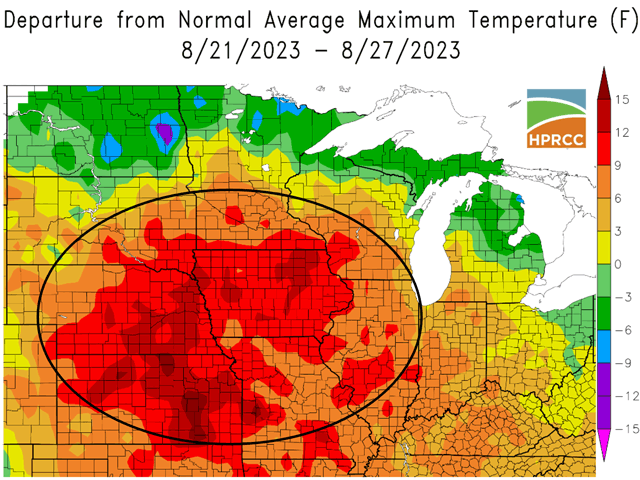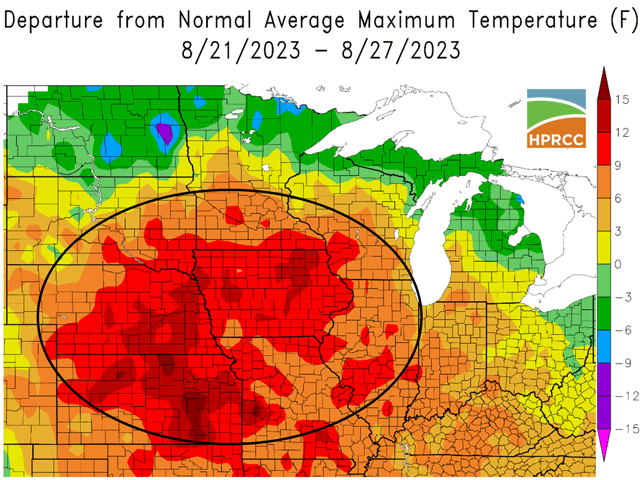Ag Weather Forum
When August Heat Kept US Corn Production From Record Levels
The week of Aug. 21-27 saw record heat cover the central United States as high temperatures and high dew points led to jungle-like conditions. Daytime high temperatures of 9 to 15 degrees Fahrenheit above normal were noted in much of the Western Corn Belt; air temperatures topping 100 F were common. In addition, the heat index -- measuring the impact of air temperature and relative humidity on a person's body -- soared to over 120 F during the week.
The blistering heat, along with no rain, brings the potential for crop yields to falter after mild and rainy conditions during July and early August. And, looking back over the past two decades, we find a couple years where a hard dose of August heat caused a decline in final USDA corn yield and production numbers compared to the first official estimate. The impact on both occasions reduced what were initially expected to be record corn crops.
Crop year 2000 is the first occurrence to note where August heat took the top off expected record corn production. In August 2000, the USDA National Agriculture Statistics Service (NASS) corn production estimate was a new record (for the time) of 10.4 billion bushels (bb), with a then-record yield of 141.9 bushels per acre (bpa). However, the final production estimate after revisions came in at 9.9 bb -- about 5% below the August estimate -- with a yield of 136.9 bpa (about 4% below the August estimate).
P[L1] D[0x0] M[300x250] OOP[F] ADUNIT[] T[]
The NASS review of crop year 2000 had these comments about the late summer heat impact on yield: "In the Western Corn Belt and Great Plains, crop conditions slowly deteriorated due to excessive heat and increasing moisture shortages."
The 2010 crop season had an even more pronounced drop in corn production due to August heat. The NASS August 2010 corn production total was pegged at a record 13.4 bb, up 2% from the 2009 record of 13.1 bb. Corn yield was forecast at a record high 165.0 bpa, up 0.3 bushel from the 2009 yield record of 164.7 bpa.
However, the final production number was much lower. The January 2011 USDA annual report estimated "Corn for grain production ... at 12.4 bb, down 1% from the Nov. 1 forecast and 5% below the record high production of 13.1 bb set in 2009. U.S. grain yield for 2010 is estimated at 152.8 bpa ... down 1.5 bushels from the November forecast and 11.9 bushels below the record high yield of 164.7 bpa set in 2009."
Corn production and yield were both around 7.5% below the first estimate in August 2010. USDA's 2010 annual review of the crop year 2010 had this note about hot and dry conditions in August: "During August, a broad area of unfavorable dryness stretched from the south-central United States into the Ohio Valley and the lower Great Lakes region. The late-summer dryness, along with a continuation of hot weather, trimmed yield prospects for some rain-fed summer crops."
It needs to be noted that the total crop year conditions in 2000 and 2010 were not the same as we have seen in 2023. One big difference between those other years and this one is that the more-temperate July conditions of 2023 in the Corn Belt were not part of the scene in 2000 and 2023.
But the impact of a late summer heat wave -- especially considering the heat surge that covered the central U.S. Aug. 21-27 -- cannot be ignored for its potential effect on crops as they move closer to harvest time.
Bryce Anderson can be reached at Bryce.Anderson@dtn.com
Follow him on X, formerly known as Twitter, @BAndersonDTN
(c) Copyright 2023 DTN, LLC. All rights reserved.






Comments
To comment, please Log In or Join our Community .